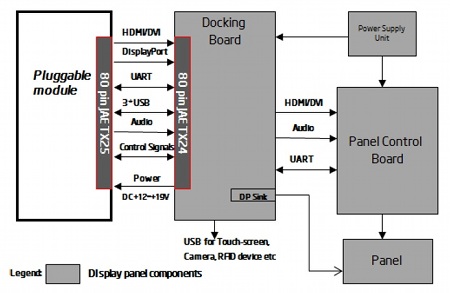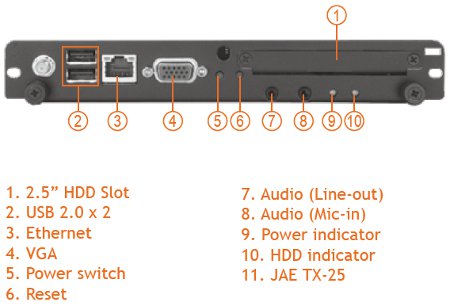Signage systems support Intel’s Open Pluggable Specification
Aug 19, 2011 — by Eric Brown — from the LinuxDevices Archive — 71 viewsAxiomtek announced a digital signage computer that adheres to Intel's signage-specific Open Pluggable Specification (OPS). Sold either separately or inside the 31.5-inch OFP320, the OPS860 module includes Intel's 2.1GHz “Sandy Bridge” Core i7 processor, 4GB DDR3 memory, gigabit Ethernet and PCIe, dual USB 2.0 ports, plus a VGA port.
Intel announced its Open Pluggable Specification (OPS) in October of last year in an attempt to address digital signage market fragmentation and simplify installation, usage, maintenance, and upgrades. OPS defines a standardized module and related interconnections "to insure compatibility and ease of integration between digital signage components from multiple vendors," Intel said at the time.


Two views of the OPS860 module
(Click on either to enlarge)

Intel's Open Pluggable Specification block diagram
OPS860 and OFP320
The OPS860 and display-equipped OFP320 are the first OPS-compliant digital signage systems to offer a 2.1GHz Intel Core i7 processor from the latest Sandy Bridge "2nd Generation" line, claims Axiomtek. The processor's AMT 7.0 capabilities are supported for remote management, says the company.

OPS860 port detail
(Click to enlarge)
Both computers support up to 4GB DDR3 memory, and supply a 2.5-inch SATA hard disk drive (HDD) bay. Standard I/O is also similar, with a gigabit Ethernet port, dual USB 2.0 ports, a VGA ports, and two audio ports, says Axiomtek.

OFP320 signage PC
Meanwhile, the OFP320 takes the OPS860 and houses it inside a 31.5-inch display, said to feature 1920 x 1080 resolution and 2500:1 contrast. VESA FPMPMI compliant flat panel suspension mounting is available, according to Axiomtek.
Features and specifications listed for the OPS860 module include:
- Processor — rPGA socket supporting 2.1GHz Intel Core i7 ("Sandy Bridge"); Intel QM67 chipset
- Memory — up to 4GB DDR3 via single SODIMM
- Storage — 2.5-inch SATA HDD bay
- Expansion — PCIe Mini slot
- Wireless — optional 802.11b/g (via PCIe)
- Networking — gigabit Ethernet port
- Standard I/O:
- 2 x USB 2.0
- VGA
- Audio line-in, mic-in
- OPS JAE connector I/O:
- USB 2.0
- RS232
- DVI
- DisplayPort
- Other features — power/HDD LEDs, watchdog timer
- Operating temperature — 32 to 140 deg. F (0 to 54 deg. C) with 0.7m/s airflow (OPS requirement)
- Dimensions — 7.1 x 4.7 x 1.2 inches (180 x 120 x 30mm)
Features and specifications listed for the OFP320 all-in-one display PC include:
- Processor — rPGA socket supporting 2.1GHz Intel Core i7 ("Sandy Bridge"); Intel QM67 chipset
- Memory — up to 4GB DDR3 via single SODIMM
- Storage — 2.5-inch SATA HDD bay
- Expansion — 2 x PCIe Mini slot
- Display — 31.5-inch TFT LCD (1920 x 1080); 2500:1 contrast
- Networking — gigabit Ethernet port
- Other I/O:
- 2 x USB 2.0
- VGA
- Audio line-in, mic-in
- Other features — watchdog timer
- Power — 450W, 100~240VAC
- Operating temperature — 32 to 104 deg. F (0 to 40 deg. C)
- Dimensions — 30.74 x 18.54 x 4.64 inches (781 x 471 x 118mm)

Initially, it appeared that OPS supported only Windows Embedded Standard, but in June of this year NEC announced an SB-02SC OPS computing module (pictured at right) that also supports Linux. (Axiomtek did not release operating system support info on its new signage systems.)
Availability
Axiomtek's 31.5-inch OFP320 signage PC and OPS860 module will be available at the end of September. No pricing or operating system details were available. More information may be found on Axiomtek's OPS860 and OFP320 web-pages, respectively.
This article was originally published on LinuxDevices.com and has been donated to the open source community by QuinStreet Inc. Please visit LinuxToday.com for up-to-date news and articles about Linux and open source.